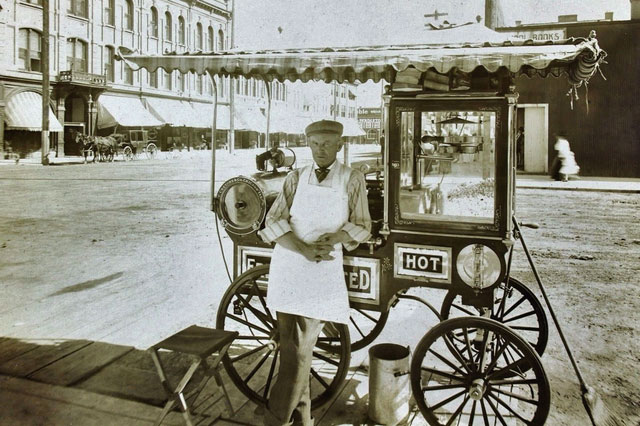If you want to save theaters after the Covid-19 outbreak, you should probably buy more popcorn, not tickets.
For moviegoers, buying popcorn at the cinema is not uncommon. But not many people know that popcorn was once banned from the cinema, and experienced many ups and downs before it became the savior of today’s theaters.
Born in British Columbia
Historical evidence shows that corn originally appeared in what is now Mexico 10,000 years ago. As early as 3600 BC, the Mexican people of today and the indigenous peoples of South America have known about popcorn.
By roasting corn kernels that cause them to explode because the compressed water and starch from the seeds are released when exposed to high heat, ancient popcorn is often considered a treat. Archaeological evidence shows that around 3,600 years ago, Native Americans detonated corn in clay pots with small holes in the lid.
 3600 years ago, Native Americans detonated corn in a clay pot with a small hole in the lid.
3600 years ago, Native Americans detonated corn in a clay pot with a small hole in the lid.
Western encroachment in the Americas exposes them to corn and popcorn. Because the taste is quite bland, the housewives added sugar butter to the popcorn for breakfast. However, until now, popcorn is still a very rare side food. Even with frills, popcorn is not people’s favorite street food.
It wasn’t until 1893 that the first steam popcorn roaster was invented by Charles Cretors that the situation gradually improved. The aroma of roasting popcorn and the explosion process attracted a lot of people, especially when the vendors often stand in front of supermarkets, fairs …
Also, since corn was quite cheap, it only cost around 5-10 cents per bag, which was adequate for the income of many households at that time. The invention of the popcorn maker made the price of this sweet, buttery-tasting food even more attractive.
However, popcorn is still just street vendor’s junk food, even banned from the theater. Although they appeared in circuses, festivals and many entertainment activities, they were absolutely not present at the beginning of theater or cinema. So what changed everything?
 Popcorn cars have created a snack revolution.
Popcorn cars have created a snack revolution.
Goods forbidden to the savior
Before the Great Depression of the 1930s, popcorn was the most banned commodity in cinemas or theaters. In fact, before the first film was shown in 1896, the theater was the primary entertainment venue for the upper class.
As the show’s scene needed the attention of the public and the high culture of the time, snacking on things like popcorn was considered rude. Even other snacks were not allowed during the show.
In April 1896, the first film was shown to audiences in New York City using equipment from inventor Thomas Edison. In 1902, the first electric cinema was built, and it was also the first to show only movies, not other shows.
Right now, all movies are silent and require people with knowledge and skills to read the lines to translate or understand the content. Movies intended for theaters at the time were primarily aimed at the sophisticated aristocracy and were to ban popcorn or distracting snacks.
 Early cinematographic works were often silent films with translators and pianists, so eating and drinking in theaters was considered rude.
Early cinematographic works were often silent films with translators and pianists, so eating and drinking in theaters was considered rude.
The sounds of eating and drinking will affect people while watching movies as well as reading translations. Plus, movie theater owners don’t want their facilities to be tainted with junk food, especially in places where elites congregate.
By 1927 the film had a reputation and whether they were literate or not, they could enjoy it whether they could read it or not. Taking the opportunity, a series of popcorn stalls lined up outside cinemas to sell food to the working class or middle class who want to watch movies.
However, cinemas still ban popcorn because they want to keep hygiene as well as the “high class” ideology to avoid making noise in the theater. Even people who enter are checked to see if they are hiding the popcorn.
Things didn’t start to change until the Great Depression of 1930 took place. While the price of all kinds of snacks has risen, popcorn is still inexpensive due to its large supply and the very simple production process. This makes the popcorn sellers profitable.
In contrast, cinemas had to shut down massively when even the elite saved money during the Great Depression. Realizing that if you can’t find a way to make a living, the movie industry in America will quickly be wiped out and the popcorn street vendors have caught the attention of some bosses.
The story begins when R.J. McKenna, director of a chain of 66 theaters in the United States, although he hates popcorn, decides to sell it in the hallway of the theater for a profit.
 Popcorn and junk food officially entered theaters thanks to the Great Depression
Popcorn and junk food officially entered theaters thanks to the Great Depression
In 1938, when McKenna decided to sell popcorn in theaters, sales of theater tickets after subtracting expenses were almost nil but in return they made almost $ 200,000 in profit selling popcorn. This figure, if inflation is included, will now amount to $ 3.5 million.
Knowing that he discovered the gold mine, McKenna decided to reduce the ticket price from 50 cents to 15 cents to attract more visitors to the film, in return the theater will make a profit by selling popcorn and drinks. From there, American cinema began selling all kinds of snacks and drinks for profit. The drop in ticket prices has also resulted in an increase in the number of moviegoers and indirectly an increase in industry profits.
However, popcorn is still just one of the many snacks of this time, especially when the Great Depression is over and the cost of living is gradually picking up. So why can they beat other junk foods to become the movie icon?
Rise up through the war
During World War II, the sugar supply chain for America was interrupted. The government also prioritized supplying the military with sugar, which resulted in a shortage of sugar, candy or candy on the stalls.
As a result, movie theaters are nothing more than popcorn, the only brilliant product sold to the public. By the end of World War II, Americans had consumed three times as much popcorn as before the war, and this junk food has officially become a movie theater symbol.
 About 50% of the popcorn consumed in the United States comes from theaters.
About 50% of the popcorn consumed in the United States comes from theaters.
Even as television grew in the 1950s, the popcorn industry continued to grow 500% more than before, with households that bought snacks at home watching television more.
Even so, about 50% of the popcorn consumed in the United States comes from movie theaters, and this business model exists today. After all, the movie theater can get 100% of the popcorn and drink sales, but it can only get around 40% of the ticket sales because it has to divide them with the film producers and distributors.
Today, the profits from popcorn are the main source of income for cinemas to maintain their operations, including the costs of lighting, air conditioning and labor … So if you are a movie buff and you want the cinema to stay active. If you can move, it’s not a movie ticket, it’s popcorn you have to buy.


